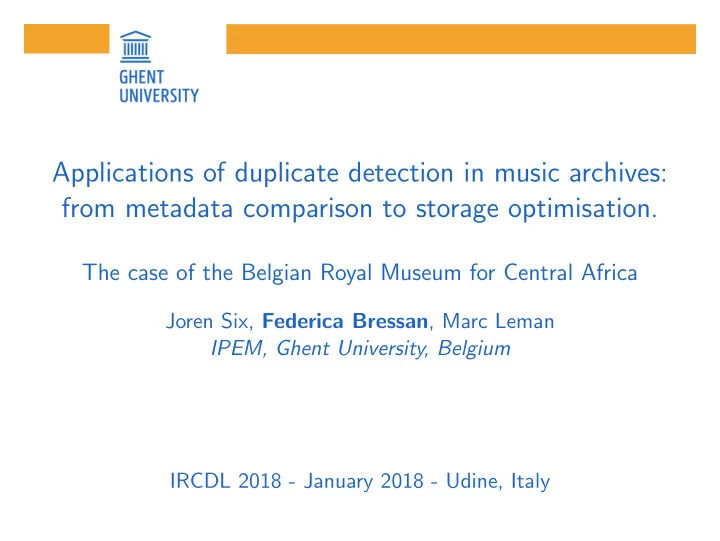

Applications of duplicate detection in music archives: from metadata comparison to storage optimisation. The case of the Belgian Royal Museum for Central Africa Joren Six, Federica Bressan , Marc Leman IPEM, Ghent University, Belgium IRCDL 2018 - January 2018 - Udine, Italy
Overview I Duplicate detection Applications for duplicate detection To complete meta-data To improve listening experiences To segment tracks To merge archives Robustness against speed changes Acoustic fingerprinting Case studies Case study: RMCA archive Case study: IPEM archive Conclusion 2/21
Duplicate detection Definition (Duplicate detection system) A system that is able to compare every audio fragment in a set with all other audio in the set to determine if the fragment is either unique or appears multiple times in the complete set. The comparison should be robust against various artefacts. 3/21
Duplicate detection Duplicates contain the same recorded event but can differ by: ◮ Noise from various sources ◮ Carrier dependent ◮ Magnetic tape hum/hiss ◮ Phonographic disc pop/clicks. . . ◮ Imperfections from A/A or A/D conversion, among which changes in playback speed ◮ Various dynamics artefacts: intensity, compression, . . . ◮ Digital encoding format 4/21
Duplicate detection to complete meta-data Original Duplicate meta-data meta-data fi eld1 fi eld1 fi eld 2 fi eld 3 fi eld 3 5/21 Figure: Duplicate detection to complete meta-data.
Duplicate detection to improve the listening experience Listener Duplicate Original Figure: Duplicate detection to improve the listening experience. 6/21
Duplicate detection for segmentation Recording 1 Recording 2 Recording 3 Unsegmented recording Figure: Duplicate detection for segmentation. 7/21
Duplicate detection for merging archives Allows to identify unique items in merged archives. All above applications apply ◮ Meta-data improvement ◮ Improved listening experience ◮ Reuse segmentation points Figure: Merging two archives: two plus three equals four. 8/21
Robustness against speed changes Robustness to speed change is needed if: Original ◮ Many wax cylinders are present ◮ Uncalibrated tape recorders were used Duplicate ◮ For historical archives consisting of merged archives Figure: Robustness against speed changes. 9/21
Acoustic fingerprinting ◮ Mature MIR technology ◮ Allows duplicate detection ◮ Efficient algorithms [5, 1, 3] ◮ Some robust to speed change [3, 4] ◮ Implementations available [3] Figure: An acoustic fingerprinting approach 10/21
Acoustic fingerprinting The software used is Panako: Article Panako [3] Website http://panako.be License GNU Affero GPL To operate Panako you do not need an Figure: The effect of speed MIR specialist modification on a fingerprint 11/21
Case study: RMCA archive Collection of the Royal Museum for Central Africa, Tervuren, Belgium See [2] ◮ More than 35 000 items ◮ Mainly field recordings from Central Africa ◮ First recordings from 1890s ◮ Many analogue carriers types Figure: Meta-data on file ◮ Challenging meta-data at the RMCA-archive 12/21
Case study: RMCA archive Original Duplicate Duplicate detection on this large historical archive has to aims: ◮ Compare meta-data between pairs meta-data meta-data ◮ Quantify the amount of duplicates fi eld1 fi eld1 fi eld 2 fi eld 3 fi eld 3 2.5% (887 of 35306) recordings were found Figure: Main application: to be duplicates segmentation re-use 13/21
RMCA archive Field Empty Different Exact match Fuzzy or exact match Year 20.83% 13.29% 65.88% 65.88% People 21.17% 17.34% 61.49% 64.86% Country 0.79% 3.15% 96.06% 96.06% Province 55.52% 5.63% 38.85% 38.85% Place 33.45% 16.67% 49.89% 55.86% Language 42.34% 8.45% 49.21% 55.74% Title 42.23% 38.40% 19.37% 30.18% Collector 10.59% 14.08% 75.34% 86.71% Table: Comparison of pairs of meta-data fields 14/21
RMCA archive Original title Duplicate title Warrior dance Warriors dance Amangbetu Olia Amangbetu olya Coming out of walekele Walekele coming out Nantoo Yakubu Nantoo O ho yi yee yi yee O ho yi yee yie yee Enjoy life Gently enjoy life Eshidi Eshidi (man’s name) Green Sahel The green Sahel Ngolo kele Ngolokole Table: Pairs of fuzzy matching titles. 15/21
Case study: IPEM archive The archive of Institute for Psychoacoustics and Electronic Music (IPEM) ◮ About 1800 open reel tapes ◮ Early electronic music ◮ Represent 1960s-1970s musical avangarde in Belgium Figure: Open-reel tape from the IPEM archive 16/21
Case study: IPEM archive The archive has been digitized twice. Recording 1 Recording 2 Recording 3 Once in 2001 and in 2014 with higher Unsegmented recording quality. Planned to re-use segmentation Figure: Main application: and meta-data from first digitization. segmentation reuse 17/21
Conclusion ◮ Presented applications of duplicate detection ◮ Acoustic Fingerprinting allows duplicate detection ◮ Illustrated applications with two case studies ◮ Pointer to software for duplicate detection 18/21
Bibliography I Jaap Haitsma and Ton Kalker. A highly robust audio fingerprinting system. In Proceedings of the 3th International Symposium on Music Information Retrieval (ISMIR 2002) , 2002. Joren Six, Federica Bressan, and Marc Leman. Applications of duplicate detection in music archives: From metadata comparison to storage optimisation - The case of the Belgian Royal Museum for Central Africa. In Proceedings of the 13th Italian Research Conference on Digital Libraries (IRCDL 2018) , In Press - 2018. 19/21
Bibliography II Joren Six and Marc Leman. Panako - A scalable acoustic fingerprinting system handling time-scale and pitch modification. In Proceedings of the 15th ISMIR Conference (ISMIR 2014) , pages 1–6, 2014. R. Sonnleitner and G. Widmer. Robust quad-based audio fingerprinting. Audio, Speech, and Language Processing, IEEE/ACM Transactions on , PP(99):1–1, 2016. 20/21
Bibliography III Avery Li-Chun Wang. An industrial-strength audio search algorithm. In Proceedings of the 4th International Symposium on Music Information Retrieval (ISMIR 2003) , pages 7–13, 2003. 21/21
Recommend
More recommend